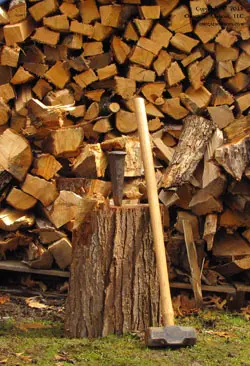Wood Splitting Teaches Us About Knotty People

Wood splitting teaches us about the strength and adaptability of knotty people. Their thinking lives at the crossroads of different views.
Thinking at the intersection of ideas is very helpful in solving problems. The book, The Medici Effect by Frans Johansson, says this is a strong source of creativity and innovation. Wood splitting teaches us about knotty people whose thinking lives here.
Wood Splitting
A childhood friend taught me to split wood using a chisel and long-handle hammer. He said I should learn first on clean, straight logs. They should not have knots. Knots often occur where branches sprouted, did not fully grow or met other branches in a “V.”
Wood Splitting Teaches Us About Knotty People
In business we like to have everyone moving in the same direction. This is true with wood splitting. When all the grains run in the same direction, the log is easier to split.
Knots cause grains to curve. They make the log stronger. Wood splitting is harder. It takes more time too.
The thoughts of knotty people are also stronger than those whose thoughts run along clean, straight lines. Their thinking lives at the crossroads of several views. Nothing is simply front and back, black and white.
Their thinking gives ours firms strength. They make us more resistant to outside forces seeking to split and weaken us.
Wood Splitting Teaches Us Adaptability
The thinking of knotty people makes our firms more adaptive too. Branches allow a tree to spread and catch more light. This makes the tree more adaptable. It can lose the top portion of its trunk and still live.
Knotty people do the same. Since they think along different lines, they make our firms more adaptable. They do not rely on one line of thought to guide how they see things.
Wood Splitting Teaches Us Management
Knotty people are harder to manage. It is easy to discard them. When I first started wood splitting, I ended up with a lot of knotty logs left.
Finally, I had to split them. I had to think hard how to do it. I became a better wood splitter though. They taught me more than the clean, straight ones did.
Knotty people are like knotty wood. They make you stop and think. They make us better managers. If we want to stop and think that is.
Greger Wilkerstand as an excellent related read, “What I Learned from Chopping Wood.”



Pingback : What I learned from chopping wood - Greger Wikstrand
Hi Mike! Your readers will find my companion post here: http://www.gregerwikstrand.com/learned-from-chopping-wood/
Consider two types of wood: the straight-grained wood and the knotty wood. If we want to develop the skill of wood splitting, we will get limited results at most using the straight-grained wood. The knotty wood on the other hand has many more challenges and thus better skills development potential.
Similarly, simplified situations / assignments don’t offer the learning and skills challenges that the “messy” / real-world (knotty) ones. Thus whether in a job situation or in formal education, it’s once again the knotty ones that are most challenging, leading to the richer, more creative outcomes.
So true, John. We become heroes when we can handle difficulties. Otherwise, we’re just caretakers.